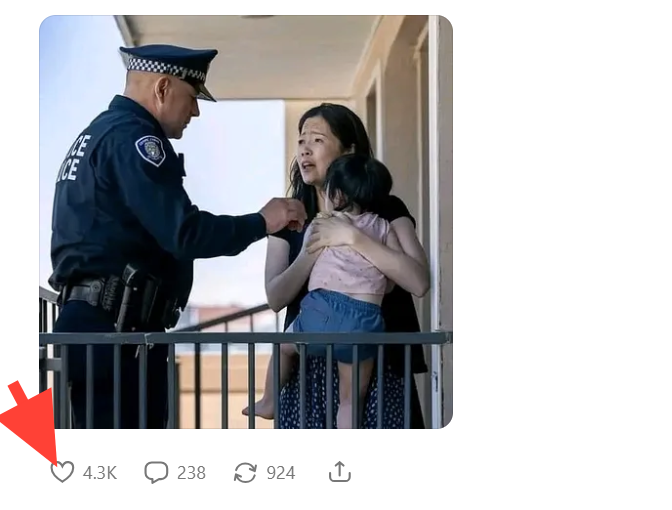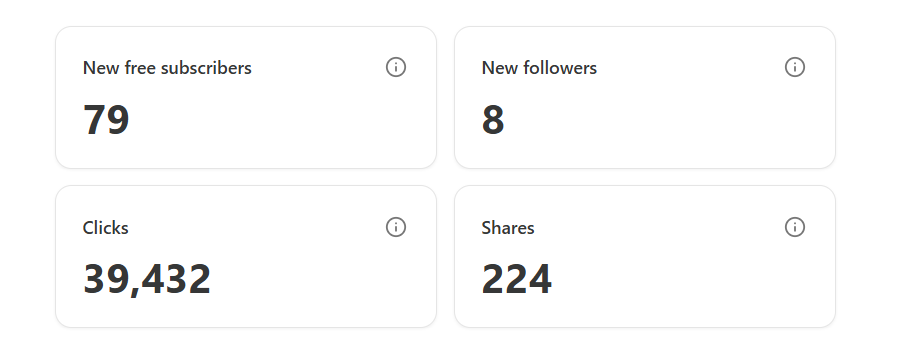Why Your Substack 'Notes' Aren’t Working (And How to Fix Them)
A step-by-step system for reach, traction, and connection. Steal This Notes Strategy.
A few weeks ago, I noticed something strange in my Substack stats.
My newsletters were steady. My long-form pieces were pulling in readers. But the real spike? It came from Notes.
That little feature, tucked away between big essays and email blasts, was quietly becoming the heartbeat of my growth. New subscribers trickled in. Conversations started with writers I admired but never thought I’d cross paths with.
Here’s one of my notes that received some decent traction:
And here are the stats as of today (September 5, 2025)
And it hit me: we’re underestimating Notes.
In reality, Notes are where the algorithm lives. They’re Substack’s version of the town square. A place where reach compounds, where influence gets shared, and where strangers discover your work without even looking for you.
So today, I’m going to share the strategy I now use to make Notes a powerful growth lever.
This is the exact plan that helped me grow visibility, sharpen my ideas, and connect with bigger writers.
It’s a mix of rhythm, format, and intent—and I’ll give you sample Notes you can use right away.
If you’ve been posting randomly, or not at all, this will provide you with a map to follow.
I’ll walk you through the weekly system, show you the formats that get the most traction, and give you real-world examples of trending Notes you can adapt for your own work - and, this is all FREE for you!
1. The Notes Strategy: The Big Picture
Think of Notes as your top-of-funnel magnet.
Newsletters: Deep, email-based, relationship building.
Notes: Public, fast-moving, discovery-driven.
The two must talk to each other. Notes draw people in. Newsletters convert them into long-term readers.
The most successful Substackers I’ve studied use Notes in 3 ways:
To show up regularly (visibility).
To seed curiosity that points to longer posts (traffic).
To interact and respond to others (community).
2. The Work Plan: Weekly Rhythm for Maximum Reach
Monday:
→ Reflective Note. Share a personal tension, realization, or lesson from the weekend. (Example: “I broke my own productivity rule yesterday—and it taught me something I didn’t expect.”)
Wednesday:
→ Micro-tip with proof. Short, practical idea supported by a screenshot, visual, or quick story. (Example: “This one calendar trick freed up 30 minutes for me today. Screenshot attached.”)
Friday:
→ Engagement Note. Comment on or respond to a bigger Substacker’s Note. Add your spin, make it thoughtful. This builds visibility in their network.
Sunday (optional):
→ Teaser Note. Share one insight from your upcoming newsletter and link back.
Goal: 3–4 Notes per week. Enough to stay visible without overwhelming.
3. The Formats That Win
Confessional:
“I wasted 2 hours today pretending to plan. Procrastination wears a productivity costume.”Analogy/Metaphor:
“Your inbox is like a fridge—if you don’t clear it out, everything inside starts to stink.”Mini-tip (actionable):
“Try the 3-minute rule: if a task takes less than 3 minutes, do it right now. My mornings feel 10x lighter.”Open-ended question:
“What’s the one productivity ‘rule’ you broke—and never went back to?”Visual note (screenshot/handwritten page):
A peek into your actual system. People engage with what feels raw and real.
4. Sample Notes You Can Post (Steal These Today)
Example 1 – Confessional:
“My to-do list isn’t the problem. It’s the fact that I check email before I check it. Anyone else guilty of this cycle?”
Example 2 – Analogy:
“Think of focus like a muscle. If you keep flexing it with shallow tasks, don’t be surprised when it can’t lift the heavy ones.”
Example 3 – Mini-tip:
“I time-blocked my distractions today. 2:30–3 PM = scrolling. Shockingly effective.”
Example 4 – Open-ended Question:
“What’s the app you use daily that no one else seems to get excited about?”
Example 5 – Visual:
(Upload an image of your handwritten scribbles.) with the caption:
“Messy notes. Clear head. Funny how clarity hides inside chaos.”
5. The Networking Layer
Notes aren’t only about what you post. They’re about where you post.
Restack big names. Add a line of commentary. It gets you in front of their readers.
Reply thoughtfully to Notes in your niche. Not just “great post!”—add a perspective.
Share other people’s Notes with your own spin. Substack’s culture rewards generosity.
6. The Flywheel Effect
Here’s how it all compounds:
Notes → Discovery (people see you in feeds, through restacks).
Engagement → Network (comments & replies build reputation).
Newsletter → Depth (turn casual scrollers into real subscribers).
Paid content → Monetization (your true fans stay, support, and spread the word).
The 15-Minute Notes Sprint Framework
How to create a high-performing Note in 15 minutes or less — without overthinking.
Step 1 — 5 Minutes: Brainstorm Fast
Don’t stare at a blank box. Mine your day for raw material. Ask yourself:
Did I fail at something? (Confessional)
Did I notice a metaphor? (Analogy)
Did I use a trick that worked? (Micro-tip)
Did I wonder about something? (Question)
💡 Shortcut: Scroll your own journal, to-do list, or even your text messages. There’s always a Note hiding there.
Example:
Journal entry: “Felt overwhelmed by email.”
→ Turned into a Note: “Inbox is like a fridge. Leave it alone too long, and everything inside starts to stink.”
Step 2 — 7 Minutes: Draft Using a Proven Format
Pick one format and plug your idea in.
Confessional Format:
“I [did embarrassing/real thing]. Turns out, [unexpected lesson].”
Example: “I wasted 30 minutes reorganizing my desk instead of writing. Procrastination wears a productivity costume.”
Analogy Format:
“[Thing in life] is like [object/metaphor]. Here’s why.”
Example: “My brain is like Chrome with 27 tabs open. Except 5 are frozen, and music’s playing from nowhere.”
Micro-tip Format:
“Here’s one trick that [result].”
Example: “Try the 3-minute rule: if it takes less than 3 minutes, do it now. My mornings feel 10x lighter.”
Question Format:
“What’s the one [topic] you [relatable experience]?”
Example: “What’s the one productivity rule you broke—and never went back to?”
Step 3 — 3 Minutes: Polish for Hook + CTA
Your Note needs to stop the scroll and spark engagement. Do two quick passes:
Hook Check – Does the first line make someone pause?
Example: Instead of “I procrastinated,” say: “I just spent 40 minutes pretending to work.”CTA Check – Does it invite a response or thought?
Add a light nudge: “Anyone else guilty?”, “What’s your version of this?”
The 15-Minute Flow in Action
Minute 0–5: Scribble raw idea → “Procrastination disguised as planning.”
Minute 6–12: Plug into Confessional Format → “I spent 45 minutes organizing my desk so I wouldn’t have to write.”
Minute 13–15: Add hook + CTA → “I spent 45 minutes organizing my desk so I wouldn’t have to write. Procrastination wears a productivity costume. Anyone else guilty?”
And you’re done. No endless editing. Post it.
Bonus: Printable Checklist
Here’s the sprint boiled down:
✅ Grab raw material (journal, to-do, thought, fail).
✅ Pick a format (confession, analogy, tip, question).
✅ Write fast (7 mins, no editing).
✅ Polish hook + CTA (3 mins).
✅ Hit post. Don’t tinker.
Takeaway
If newsletters are your home, Notes are the front porch. People don’t ring the doorbell without stepping onto the porch first.
So stop treating Notes like throwaway tweets.
Treat them like growth levers.
Write with clarity.
Engage with intent.
And remember: it’s the small, consistent Notes that create the big wins over time.
This week, try posting 3 Notes using the formats I shared: one confessional, one tip, one question. Pay attention to which one sparks the most conversation. That’s your signal.
Checkout a few of my behind the paywall articles (meaningful and high-value)
I Was Juggling 3 To-Do List Apps until My Son Taught Me This
"You're not living. You're just existing," my son told me last Tuesday morning.
Will an AI Girlfriend Make You Less Lonely or More
I was at a café when a guy at the following table whispered, “I’m proud of you.” No one else was there. Just him, a latte, and a lock screen with the name “Ivy.” Two minutes later, he smiled, kissed the phone, and tucked it away like a secret.
If my words made you pause, smile, think, or scribble a note for later — consider supporting the journey. You can:
Buy me a coffee (or a virtual hug)
Subscribe to my Substack for more deep dives and digital wisdom
Follow my Medium for stories that blend life, tech, and productivity
Grab my templates or digital goodies on Gumroad
See meaningful videos on YouTube







